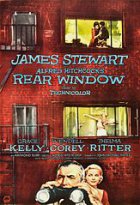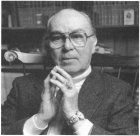
Rear Window
- PG
- Year:
- 1954
- 112 min
- 7,014 Views
FADE IN:
INT. JEFFERIES' APARTMENT - DAY - LONG SHOT
Although we do not see the foreground window frame, we see
the whole background of a Greenwich Village street.
We can see the rear of a number of assorted houses and small
apartment buildings whose fronts face on the next cross-town
street, sharply etched by the morning sun.
Some are two stories high; others three; some have peaked
roofs, others are flat. There is a mixture of brick and wood
and wrought iron in the construction.
The apartment buildings have fire escapes, the others do
not.
The neighborhood is not a prosperous one, but neither is it
poor. It is a practical, conventional dwelling place for
people living on marginal incomes, luck -- or hope and careful
planning.
The summer air is motionless and heavy with humid heat.
It has opened windows wide, pushed back curtains, lifted
blinds and generally brought the neighborhood life into a
sweltering intimacy. Yet, people born and bred to life within
earshot and eye glance of a score of neighbors have learned
to preserve their own private worlds by uniformly ignoring
each other, except on direct invitation.
THE CAMERA PULLS BACK until a large sleeping profile of a
man fills the screen. It is so large that we do not see any
features, but merely the temple and side of the cheek down
which a stream of sweat is running.
THE CAMERA PANS OFF this to the right hand side of the window,
and MOVES TO a thermometer which is hanging on the wall just
outside the window. It registers 84.
THE CAMERA MOVES ON into the open, and brings nearer to us a
room with a large studio window. We are able to see inside
this room. A short, balding man is standing near the window,
shaving, using a small bowl of water and a portable mirror
which he has set up on a shelf.
To the right of him is a battered upright piano. On top of
the piano is a radio. The music selection coming from the
radio stops, and the announcer is heard.
ANNOUNCER:
The time -- 7:
15 A.M., WOR, New York.The temperature, outside, 84 --
Friends -- is your life worth one
dollar?
The man shaving quickly puts down his razor, hurries to the
radio, and changes the station, moving past a number of
commercial voices until he again finds some music.
Contented, he returns to his shaving.
THE CAMERA MOVES ON AND OVER to a far building. It passes
over the face of this building until it comes to fire escapes.
It goes up and near enough to one which has become the outdoor
bedroom of a couple. We are near enough to see an alarm clock
hanging from the rail which is now ringing vigorously. A man
rises lazily to a sitting position. He gropes to switch the
alarm off.
We see that his pajamas are stained with sweat. In his sitting
position he leans forward and shakes somebody beside him. To
our surprise, the head of this other person -- a woman --
rises where his feet are. They have been sleeping in opposite
directions. They sit limply looking at each other with
bedraggled and weary expressions which show they enjoyed
very little sleep in the heat of the night.
THE CAMERA NOW MOVES DOWN toward the left onto another low
building. It MOVES IN A LITTLE to a living room window. Just
inside the windowsill, a small fan is oscillating. The fan
sits on the right side of the table, and to the left of it
is an automatic toaster.
Behind the toaster stands a full-bodied young woman,
apparently wearing only a pair of black panties. Her stomach,
navel, and the lower part of her chest are naked. Just below
her breasts, the curtain, partly drawn, has thrown a deep
shadow which extends upward, hiding her breasts, shoulders
and head. Two pieces of toast pop up in the toaster. She
takes them out, butters them. Then she turns around and bends
over another table on which stands an automatic coffee-maker.
She picks up the coffee-maker, and swings back to the table
to sit down. She does this so deftly that her breasts are
never exposed, but hidden by the fan as she sits down. The
fan moves back and forth as she pours coffee, far enough to
reveal that she wears no bra, but not far enough to fulfill
the exciting promise of her lack of clothes.
THE CAMERA MOVES ON to a distant street corner seen between
two buildings. The traffic is very light at this hour, but a
Sanitation Department truck moves through the intersection
spraying water out behind it to cool the pavement and keep
the dust down. Three little kids in bathing suits run behind
the truck, playing in the water.
THE CAMERA MOVES OFF and around to some buildings at the
side. As it skims this building, we see a hand emerge from
one of the windows, and remove the cover from a birdcage
which is hanging from a hook on the wall outside. In the
cage are two lovebirds -- arguing.
THE CAMERA NOW PULLS BACK SWIFTLY and retreats through the
open window back into Jefferies' apartment. We now see more
of the sleeping man. THE CAMERA GOES IN far enough to show a
head and shoulders of him.
He is L. B. JEFFERIES. A tall, lean, energetic thirty five,
his face long and serious-looking at rest, is in other
circumstances capable of humor, passion, naive wonder and
the kind of intensity that bespeaks inner convictions of
moral strength and basic honesty.
He is sitting in an Everest and Jennings wheelchair.
THE CAMERA PANS along his right leg. It is encased in a
plaster of Paris spica from his waistline to the base of his
toes. Along the white cast someone has written "Here lie the
broken bones of L. B. Jefferies."
Translation
Translate and read this script in other languages:
Select another language:
- - Select -
- 简体中文 (Chinese - Simplified)
- 繁體中文 (Chinese - Traditional)
- Español (Spanish)
- Esperanto (Esperanto)
- 日本語 (Japanese)
- Português (Portuguese)
- Deutsch (German)
- العربية (Arabic)
- Français (French)
- Русский (Russian)
- ಕನ್ನಡ (Kannada)
- 한국어 (Korean)
- עברית (Hebrew)
- Gaeilge (Irish)
- Українська (Ukrainian)
- اردو (Urdu)
- Magyar (Hungarian)
- मानक हिन्दी (Hindi)
- Indonesia (Indonesian)
- Italiano (Italian)
- தமிழ் (Tamil)
- Türkçe (Turkish)
- తెలుగు (Telugu)
- ภาษาไทย (Thai)
- Tiếng Việt (Vietnamese)
- Čeština (Czech)
- Polski (Polish)
- Bahasa Indonesia (Indonesian)
- Românește (Romanian)
- Nederlands (Dutch)
- Ελληνικά (Greek)
- Latinum (Latin)
- Svenska (Swedish)
- Dansk (Danish)
- Suomi (Finnish)
- فارسی (Persian)
- ייִדיש (Yiddish)
- հայերեն (Armenian)
- Norsk (Norwegian)
- English (English)
Citation
Use the citation below to add this screenplay to your bibliography:
Style:MLAChicagoAPA
"Rear Window" Scripts.com. STANDS4 LLC, 2025. Web. 22 Feb. 2025. <https://www.scripts.com/script/rear_window_431>.







Discuss this script with the community:
Report Comment
We're doing our best to make sure our content is useful, accurate and safe.
If by any chance you spot an inappropriate comment while navigating through our website please use this form to let us know, and we'll take care of it shortly.
Attachment
You need to be logged in to favorite.
Log In